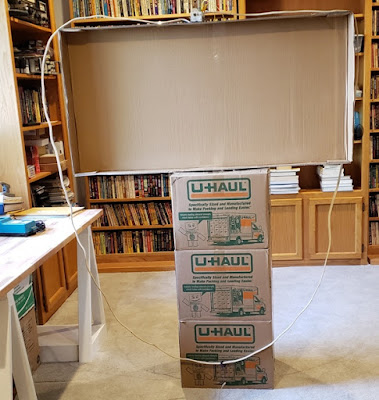 |
| After 46 years, finally a dial skirt |
SolderSmoke Podcast #222 is available:
No travelogue but… SolderSmoke
Almanac!
Memorial Day in
U.S.
End of Ramadan so Eid Mubarak!
#222 marks SIX
YEARS of Julian-ismo. He started on SS 161. Thanks Pete.
Thanks to all who sent
good wishes on Billy's graduation. He heads to Boston and the lab in a
week or so. Very proud.
------------------------------------------
Bill was on Ham Radio WorkBench Podcast
-----------------------------------------
PETE'S WORKBENCH
-- Antenna Ideas --
Don't Buy that $165 dollar dipole! It is just wire!
-- THE PHASING
RIG. Does this point to a
need for meditation? Or at least some temporary disengagement? Tribal wisdom from Pete.
-- DEAN KK4DAS's
rig. The Furlough 40. Troubleshoot. Tribal knowledge.
-------------------------------------------
-- SHAMELESS COMMERCE
DIVISION: AMAZON BOX -- SEARCH FOR ANYTHING OU WANT THERE.
-- PLEASE PUT COMMENTS ON
THE SOLDERSMOKE BLOG POSTS.
-- PLEASE CHECK OUT THE SolderSmoke YOUTUBE VIDEOS.
------------------------------------------
BILL's WORKBENCH
n
Shortwave dials and
exotic locations. Java!
n
Galaxy V VFO
Project. Series-tuned Colpitts.
n
DRAKE 2-B.
Hayseed Recap. Put the skirt back on the
old rig. Reduction drives?
SHOPPING BAG:
I got a replacement
for the Xtronics 4000 soldering station. Yaogong worked!
Ordered screws and
stuff from McMaster -- Came very fast!
Working on a resistor
kit from Mouser.
MAILBAG:
VK2BLQ's Phasing RX
with an HRO dial. Cool Retro.
Adam N0ZIB -- Cool
station. TFT screen Aluminum welded box. FB.
Karl G7AFT
BITX 40 doing USB and LSB by changing the VFO freq. Pete's
trick!
Jerry KI4IO out
in nearby Warrenton. Hope to be able to meet up soon.
Keith N6ORS's Hot
Mustard Phasing Board.
Mike N5GTF'd FULLY
INDOOR Quarantine Receiver. Need a
slogan for the antenna!
Nick M0NTV's Bread Bin
80 Quarantine rig
Bruce KC1FSZ
Quarantine 10 -- Brave man in solar minimum. But I hear 10 is opening.
Talking to Grayson
Evans KJ7UM TA2ZGE about Collins 9.9 MHz
transformers.
Talking to Alan Wolke W2AEW
about Drake 2-B stuff Was there a
reduction drive?
Paul VK3HN about
Ceramic filter spurs.
Peter VK2EMU notes no animals were harmed in the
making of my videos. But many electrons
were agitated.  |
| N6QW Phase Shift Success -- It aint over 'till the fat lady sings |







































